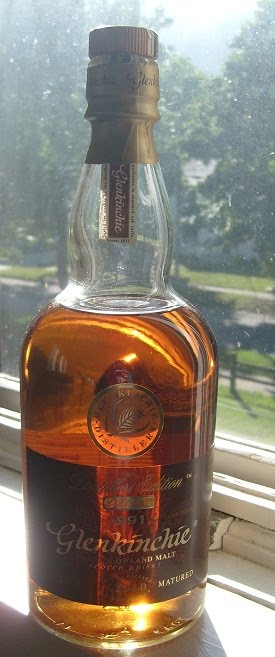
Original Blogger tags: C+, Glenkiniche 12, Glenkinchie Distiller’s Edition, B-

So, just to get it out of the way: I wanted to like Glenkinchie whisky. There aren’t many Lowland distilleries left in operation. I’m hoping that one day soon I will taste a new bottling from Glenkinchie and really enjoy it. But I found both of these to be disappointing, albeit for different reasons.
I don’t have a bottle of the Glenkinchie 12, but I tasted it at a tasting organized by Stadium Market. The program was presented by a woman from Diageo, and of course featured Diageo’s products. Her enthusiastic description of the Glenkinchie 12, which I listened to while I was tasting it, was a slightly surreal experience — an excellent example of the “don’t piss on my head and tell me it’s raining” phenomenon. I had a hard time believing that she believed what she was saying.
The Glenkinchie 12, per my notes, is unpleasantly hot and burning on both the nose and palate, despite the modest 43% ABV. On the nose it is mostly vanilla, while the major notes on the palate are citrus and cream: a lemon cheesecake, a lemon meringue pie. There are some floral and herbal notes, especially ginger, but overall I didn’t find the flavor complex enough to spend a lot of time on. I didn’t make detailed notes on the finish, but my recollection is that I just didn’t enjoy this whisky very much at all and was immediately put off the idea of buying a bottle. So the Glenkinchie 12 gets a C+.
The Distiller’s Edition is interestingly different: the casks used for the additional aging are Amontillado, which is a lighter, sweeter sherry made famous by Poe. On the nose we get a lot of sweet sherry flavors immediately. The alcohol burn of the 12 is lightened. I also get vanilla and cinnamon, with a little toffee, raisins, and lemon oil (think furniture polish). These are mostly promising notes, although a little unbalanced towards the sweet side; perhaps there is just a bit too much of the sherry influence?
The palate is where the disappointment begins. It is strangely thin and watery in texture and mouth feel, but the delivery is burning hot. There’s a difference, or at least there ought to be, between “light” and watery.” There are some nice citrus and burnt sugar flavors (lemon creme brulee, or lemon meringue pie).
The finish is where things get downright unpleasant. As the flavors fade there is a twinge of peanut brittle and toffee, which is nice enough, but it does out quickly leaving unpleasant sulfur notes: overcooked egg yolks, an overheated fan belt, and foundry clinkers.
So, I would say this is an improvement on the Glenkinchie 12, but that finish is really off-putting. My wife Grace did not like it either. The Amontillado finish concept is nice; I’d like to taste something else aged in such a cask. One of their casks may have been off, though. For a whisky in about the $75 range, if it has any off notes, they should be subtle. The poor finish here is not subtle at all. The best I can say of it is that it is “almost good,” so I give it only a B-. I’d be curious to taste this one again, since a different year might come from better casks — but again, probably not curious enough to pay for a bottle, at least until I have more confidence in the distillery. And so this bottle goes into my “giveaway” pile.
I’m told that Diageo closed Rosebank while they kept Glenkinchie, since they didn’t feel that they needed two Lowland distilleries in their “Classic Malts” portfolio. I hope to see their bottlings improve, but so far the evidence suggests that Diageo kept the wrong one open.
Saginaw, Michigan
July 26, 2010
